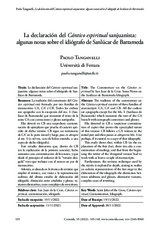Mostrar el registro sencillo del ítem
La declaración del Cántico espiritual sanjuanista: algunas notas sobre el idiógrafo de Sanlúcar de Barrameda
| dc.contributor.author | Tanganelli, Paolo | |
| dc.date.accessioned | 2023-07-20T08:01:20Z | |
| dc.date.available | 2023-07-20T08:01:20Z | |
| dc.date.issued | 2022 | |
| dc.identifier.issn | 2340-8960 | |
| dc.identifier.uri | http://hdl.handle.net/10396/25774 | |
| dc.description.abstract | La tradición del comentario del Cántico espiritual está formada por tres familias de manuscritos: CA, CA’ y CB. Todos los códices son apógrafos con la excepción del ms. S (Sanlúcar de Barrameda) que transmite el texto de la rama CA con correcciones y glosas autógrafas. Elia detectó en CB una sospechosa contaminación de ejemplares que prueba el carácter apócrifo de dicha versión: CB sigue un testimonio de CA’ en la parte inicial y luego pasa ex abrupto al ms. S (o tal vez, caso de haber existido, a una copia de dicho idiógrafo). Este estudio demuestra que, dentro de CB (en la explicación de la primera canción), hubo asimismo una contaminación de lecciones, y que desde el principio el redactor de la “versión alargada” tuvo que trabajar con al menos un par de manuscritos. Además, se ahonda en la técnica de revisión que empleó el místico, con vistas a la representación ecdótica del último estadio de elaboración del idiógrafo: distinción entre añadidos y glosas, variantes alternativas, casos complejos de reescritura. | es_ES |
| dc.description.abstract | The tradition of the commentary on the Cántico espiritual consists of three families of manuscripts: CA, CA’ and CB. All the codices are apographs except for the Ms. S (Sanlúcar de Barrameda) which transmits the text of the CA branch with autograph corrections and glosses. Elia detected in CB a suspicious contamination of copies that proves the apocryphal nature of this version: CB follows a CA’ witness in the initial part and then passes ex abrupto to Ms. S (or perhaps, if it existed, to a copy of that idiograph). This study shows that, within CB (in the explanation of the first lira), there was also a contamination of readings, and that from the beginning the writer of the ‘elongated version’ had to work with at least a couple of manuscripts.Furthermore, the revision technique used by the mystic is explored in depth, aiming to realize an ecdotic representation of the last stage in the elaboration of the idiograph: the distinction bet-ween additions and glosses, alternative variants, complex cases of rewriting. | es_ES |
| dc.format.mimetype | application/pdf | es_ES |
| dc.language.iso | spa | es_ES |
| dc.publisher | UCOPress | es_ES |
| dc.rights | https://creativecommons.org/licenses/by-nc-nd/4.0/ | es_ES |
| dc.source | Creneida 10, 105-148 (2022) | es_ES |
| dc.subject | San Juan de la Cruz | es_ES |
| dc.subject | Cántico espiritual | es_ES |
| dc.subject | Contaminación | es_ES |
| dc.subject | Idiógrafo | es_ES |
| dc.subject | Saint John of the Cross | es_ES |
| dc.subject | Contamination | es_ES |
| dc.subject | Idiograph | es_ES |
| dc.title | La declaración del Cántico espiritual sanjuanista: algunas notas sobre el idiógrafo de Sanlúcar de Barrameda | es_ES |
| dc.title.alternative | The Commentary on the Cántico espiritual by San Juan de la Cruz: Some Notes on the Sanlúcar de Barrameda Idiograph | es_ES |
| dc.type | info:eu-repo/semantics/article | es_ES |
| dc.relation.publisherversion | http://www.uco.es/servicios/ucopress/ojs/index.php/creneida/index | es_ES |
| dc.rights.accessRights | info:eu-repo/semantics/openAccess | es_ES |

